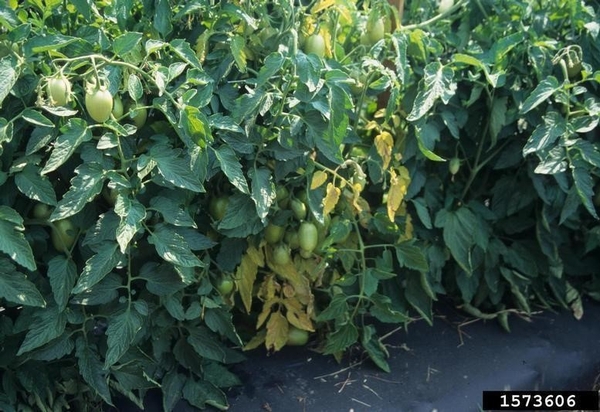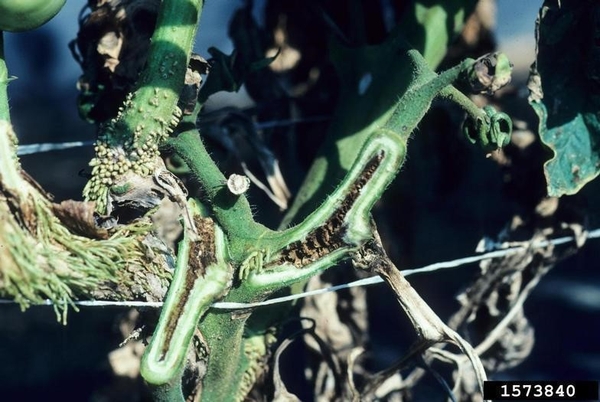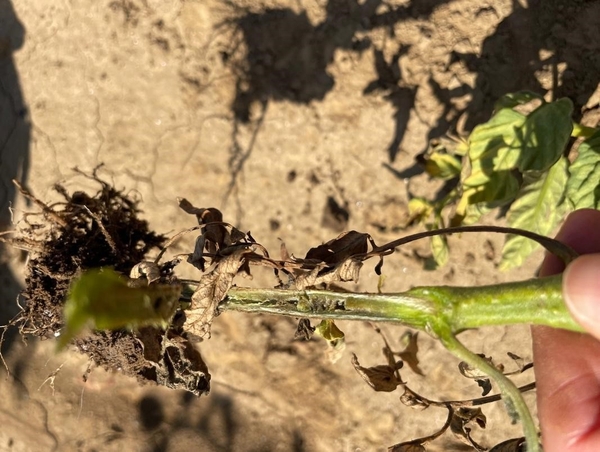General Information
Tomato pith necrosis, first observed on tomato plants in 1978, continues to be a threat to tomato production across the US. The disease most severely impacts crops where high humidity and stress conditions are present, and as a result, it is mostly a concern for greenhouse and high tunnel tomatoes, but it can also impact field-grown tomatoes. There are currently no tomato varieties resistant to pith necrosis, nor any chemical treatments commercially available, so preventing the disease with good management practices is the best way to limit its occurrence.
Pathogen
Pith necrosis is caused by multiple soil-borne species of bacteria in the genus Pseudomonas, such as Pseudomonas corrugata, P. mediterranea, P. cichorii, P. viridiflava, and P. fluorescens. There are also several other unidentified species that cause the disease. The Pseudomonas spp. that cause tomato pith necrosis are gram-negative, aerobic rods that have at least one flagella, and all are able to elicit a hyper-sensitive response on tobacco. On culture media, both P. mediterranea and P. corugata are distinguishable as nonfluorescent in contrast to P. cichorri, P. viridiflava and other Pseudomonas spp., which are fluorescent. Two varieties of colonies are produced from P. corrugata on yeast dextrose calcium carbonate media — a yellow colony with a greenish center and a round yellow-green pigmented colony with wrinkles.
Host Plants
Crops affected by the disease include both field-grown and greenhouse tomatoes.
Favorable Environmental Conditions
Pith necrosis flourishes in greenhouses and high tunnels because warm temperatures, high moisture and humidity, excessive irrigation, and drastic changes in temperature all favor the development of tomato pith necrosis. Rapid early growth as a result of excessive nitrogen in the soil can also increase the plant’s susceptibility to disease, as well as long periods of cooler, cloudy weather.
Symptoms and Signs
At early stages of infection, young leaves become chlorotic and lower leaves begin to wilt and yellow (Fig. 1). Dark brown irregular streak-like lesions might appear on the surface of the peduncles, leaf petioles, and stems (Fig. 2). Fruit might develop small round black spots that eventually become surrounded by soft rot. Even if there are no external symptoms of infection, the pith and vascular system may appear discolored (Fig. 3), and if sliced longitudinally, the stem might reveal a hollow, discolored or chambered pith (Fig. 4, 5, and 6). Adventitious roots also sometimes develop from the cracked stem (Fig. 5 & 7). The host plant can die if the lower system is severely affected; however, the disease will typically become less severe with plant growth, even if symptoms initially appear destructive (Fig. 8).
Disease Cycle and Epidemiology
Pseudomonas spp. are opportunistic and struggle to infect healthy tissue—instead they require wounds to gain entry. Disease incidence is most common when fruit is nearing mature green. Disease is spread through contamination of equipment, irrigation splash, and through seeds and plant debris with pith necrosis. The bacteria may survive on roots and aboveground residue of host plants and infected seeds.
General Disease Control
No chemical controls have been developed to prevent or manage pith necrosis. Instead, the following cultural practices can be used to effectively prevent disease spread:
- Avoid over-fertilization, especially nitrogen
- Sanitize pots, media, and all tools used for clipping and pruning
- Sanitize hands, boots, and exposed clothing
- Use clean (pathogen free) seeds
- Dispose of all plants infected with pith necrosis
- Eliminate weeds and volunteer plants
- Ensure good soil drainage and ventilation in greenhouses
Disease Control for Homeowners
Homeowners are recommended to follow the guidelines listed above. Additional suggestions for homeowners include:
- Minimize leaf moisture
- Monitor nitrogen levels in home fertilizers, as excess levels of nitrogen can increase disease susceptibility
Disease Management for Conventional Growers
In addition to the practices listed above, conventional growers should also consider the following practices.
-
Plow diseased fields to minimize residual debris
- Eliminate weeds and volunteer tomatoes near production fields
- Avoid high nitrogen input to soil across field fertilizers
Additional Resources
The NC State University Extension Plant Pathology Portal provides information on crop disease
management. The NC State University Plant Disease and Insect Clinic (PDIC) provides diagnostics and control recommendations.
The Southeastern US Vegetable Crop Handbook details important information related to the use of chemicals as treatments for plant pathogens.
The NC State University Plant Disease and Insect Clinic is a great resource for diagnosing plant problems.
References
Brust, G. 2021. Tomato Pith Necrosis. University of Maryland Extension.
Jones, Jeffrey B., Zitter, Thomas A., Momol, Timur M., and Miller, Sally A. 2016. Compendium of Tomato Diseases and Pests, Second Edition.
IPM Images "pith necrosis of tomato"
Grabowski, Michelle, and Orshinsky, Angela. 2016. Pith necrosis of tomato. University of Minnesota Extension.
University of Massachusetts Amherst. 2013. Tomato, Pith Necrosis.
Publication date: Jan. 9, 2024
Recommendations for the use of agricultural chemicals are included in this publication as a convenience to the reader. The use of brand names and any mention or listing of commercial products or services in this publication does not imply endorsement by NC State University or N.C. A&T State University nor discrimination against similar products or services not mentioned. Individuals who use agricultural chemicals are responsible for ensuring that the intended use complies with current regulations and conforms to the product label. Be sure to obtain current information about usage regulations and examine a current product label before applying any chemical. For assistance, contact your local N.C. Cooperative Extension county center.
N.C. Cooperative Extension prohibits discrimination and harassment regardless of age, color, disability, family and marital status, gender identity, national origin, political beliefs, race, religion, sex (including pregnancy), sexual orientation and veteran status.






